Bitcoin Price Analysis - Hash rate continues to increase
Bitcoin (BTC) is a decentralized digital currency released by Satoshi Nakamoto in 2009. The market cap is currently US$147.97 billion, with US$5.07 billion traded in the past 24 hours. The current spot price is down 59% from the all-time high established in December 2017.
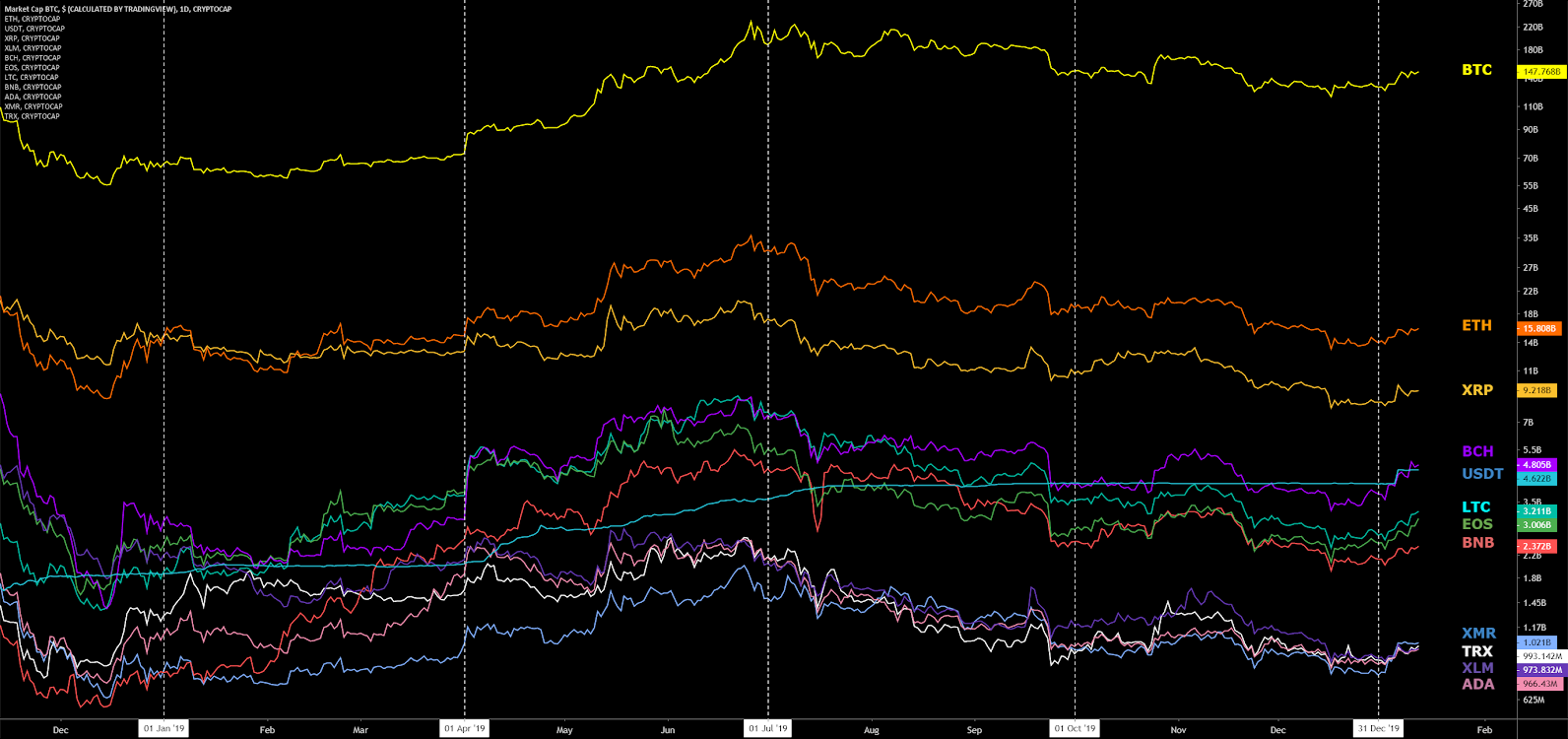
The BTC network is secured by the SHA-256 consensus algorithm. Both the network hash rate and network difficulty repeatedly making record highs in 2019. The increases were likely due to both new ASICs being manufactured as well as relatively cheap electricity available in China and elsewhere in the world enabling older ASICs to again become profitable. As BTC spot prices began to decline later in the year, the hash rate increases slowed slightly, leading to a temporary and volatile hash rate plateau.
Average block times are currently just over nine minutes, with an estimated +8.77% difficulty change at the next adjustment in two days. Network difficulty adjusts up to +/-25% every 2,016 blocks. As hash rate decreases before a difficulty adjustment, block times increase. As hash rate increases before a difficulty adjustment, block times decrease.
BTC inflation stands at 3.68% and is set to decrease in a stepwise fashion over time. The next block reward halving is estimated to be 121 days from now, around May 2020, when annual inflation will decrease to 1.80%. As miners add hash rate to the network, and maintain a block time less than 10 minutes, the estimated time until the next halving will continue to slowly decrease.

Twenty-three new SHA-256 ASICs were released in 2019, with two released by Bitmain in December. The most profitable miners are currently the; Bitmain Antminer S17+, ASICminer 8 Nano Pro, MicroBT Whatsminer M20S, and the Bitfury Tardis.
Renewable energy sources around the world, including hydroelectric and geothermal power, bring electricity prices for most mining farms to US$0.04 cents/KWh or lower. Excluding the Bitmain Antminer S3, S5, S7, and V9, all ASICs are currently profitable at this electricity price point. If electricity prices suddenly rise in areas with large mining farms, the hash rate may continue to drop in line with BTC price, as more and more ASICs become unprofitable.

Overt ASICBoost use continues to post record highs and currently accounts for 65% of all blocks mined. This competitive mining advantage will continue to squeeze out miners who do not leverage the software efficiency increase. Overt ASICBoost has no detrimental effects on the network and makes mining more profitable by lowering energy use. Other network factors that influence mining profitability include; price, block times, difficulty, block reward, and transaction fees.

On the network side, both the on-chain transactions per day (line, chart below) and average transaction value in USD (fill, chart below) have risen significantly since April 2018 and February 2019, respectively. The current record for transactions in a single day was set in December 2017, at 500,000. The current record for average transaction values in USD was set on July 24th, at US$51,000.
Since July 2019, both of these metrics have continued to decline, with transactions per day currently near 315,000 and the average transaction value at nearly US$6,300. Unconfirmed transactions have mostly held below 20,000 since August, during peak congestion, and have dropped below 5,000 during off-peak times (not shown).
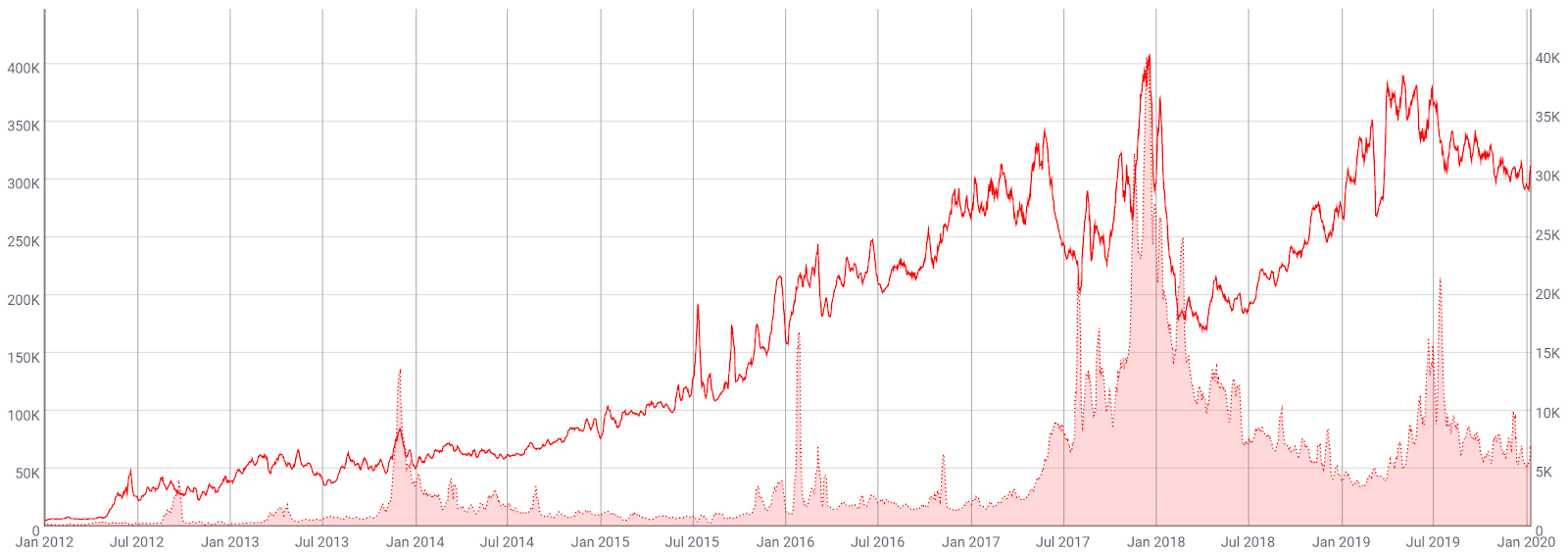
The number of transactions using SegWit has ranged between 50% and 60% over the past few months. This significant increase was largely due to VeriBlock (VBK) implementing SegWit. VBK currently accounts for 16% of all on-chain transactions. Binance, the biggest exchange globally by users and trading volume, has yet to adopt SegWit addresses.
Segwit, or BIP141, activated on August 23rd, 2017 via a user-activated soft fork. The change allows individual transactions to occupy less block space than a non-SegWit transaction, and provides an effective block size limit of roughly 2.2MB. Although both non-SegWit and SegWit transactions can be sent over the network, SegWit users pay less in accumulated fees to achieve the same number of transactions.
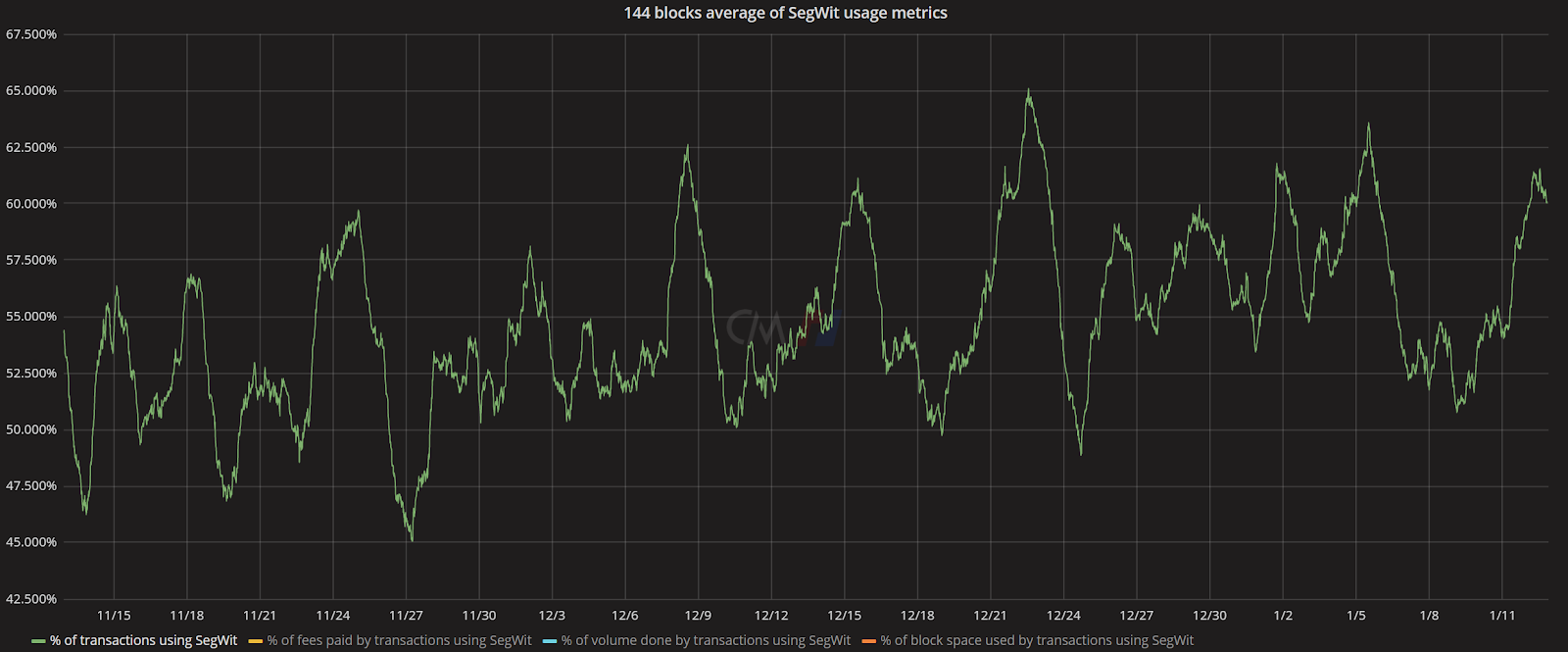
The average block size (fill, chart below) increased substantially from April 2018 to June 29th 2019, due to both an increase in on-chain activity as well as VBK, which secures other blockchains through the Proof of Proof consensus mechanism. Since June 29th, the average block size has dropped from nearly 2 MB to 1.52 MB.
The average transaction fee (line, chart below) is currently US$0.60, despite a growing block size and increased on-chain use since the record high fee of US$62 in late December 2017. Both the lack of zero-fee unconfirmed transactions and increased scalability have kept fees substantially lower than late in 2017.
Additionally, transaction batching and the increasing off-chain capabilities of Lightning Network have decreased on-chain transaction bloat. Transaction batching is most effective for entities with a high amount of on-chain transaction outputs, such as miners and exchanges.
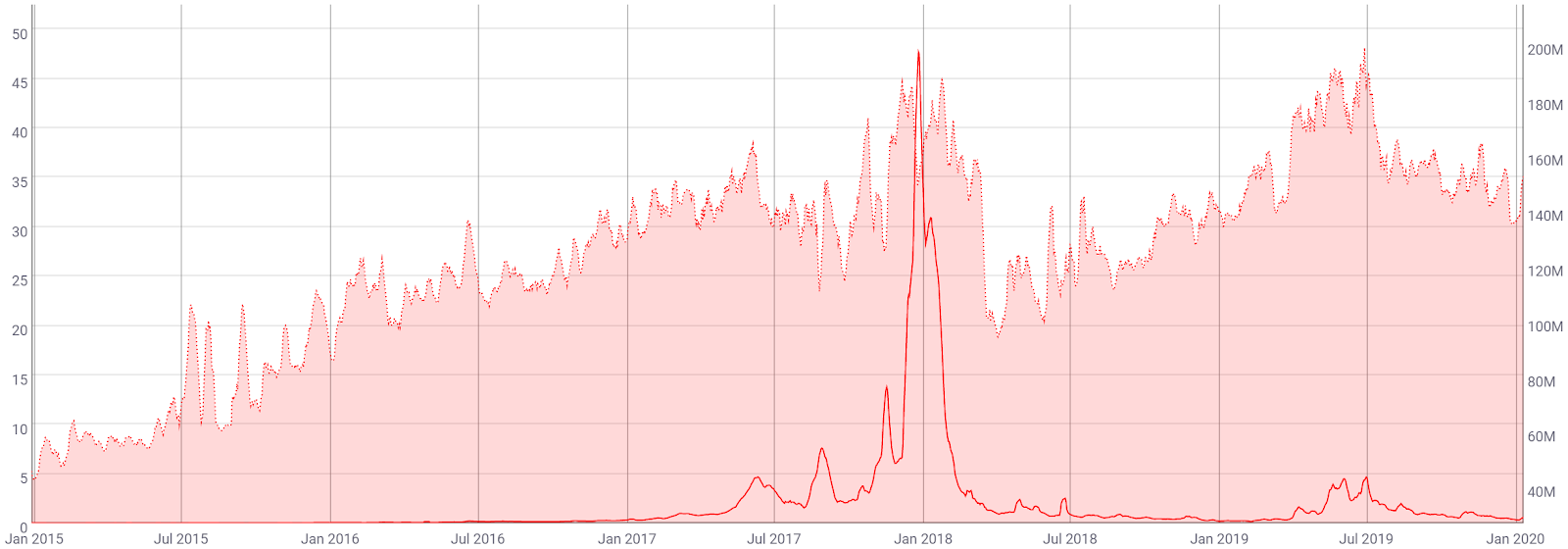
The 30-day Kalichkin network value to on-chain transactions ratio (NVT) decreased from July to late-October and is currently 75 (line, chart below). While Kalichkin's NVT does not account for inflation or the use of off-chain transactions, which would decrease the overall NVT ratio, the metric remains in the upper-third of the historic range.
The three previous highs in NVT, in February 2011, October 2014, and October 2018, were all followed by bearish price moves. Based on this metric, the probability for a local top in price will increase if another local NVT high is reached. In December 2018, NVT bottomed out at 46 before a price reversal.
Monthly active addresses (MAAs) also increased substantially, from January 2019 to mid-July 2019 (fill, chart below). MAAs grew to 850,000, from a yearly low of 550,000, and are currently around 684,000. Daily active addresses (DAAs) surpassed one million three times in 2019, on June 14th, 26th, and 28th. June 2019 was the first-month that DAAs exceeded one million since February 2018. On December 14th, 2017, DAAs exceeded 1.28 million.
The Bitcoin network has far more active addresses than any other blockchain. A large uptick or sustained increase in DAAs should be seen as a bullish indicator for market prices as it suggests an increase in on-chain BTC demand. As off-chain transaction facilities increase, daily active addresses may stagnate or decline over time.
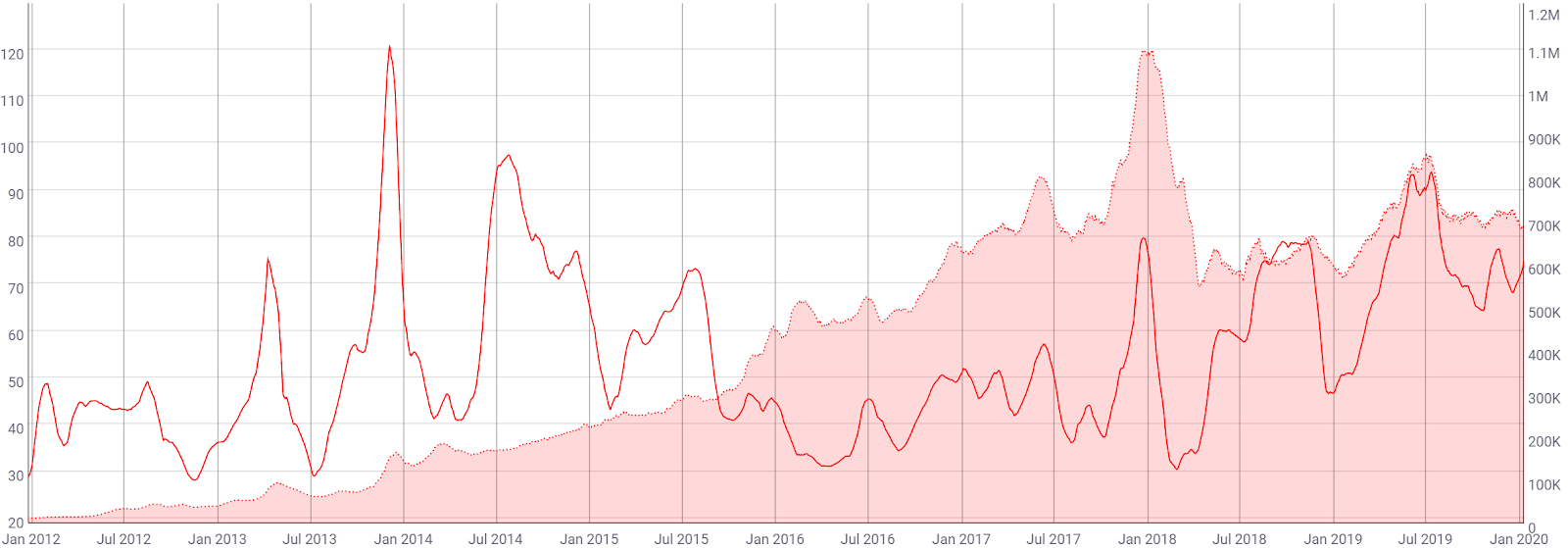
The market cap divided by the realized cap (MVRV) is another crypto-native fundamental metric used to asses overbought or oversold conditions. Realized cap approximates the value paid for all coins in existence by summing the market value of coins at the time they last moved on the blockchain.
Historically, periods of an MVRV less than one have represented oversold conditions, whereas periods of an MVRV greater than 3.5 have represented overbought conditions. Of the MVRV levels above four since January 2013, all three have coincided with record highs in price. Currently, MVRV is 1.41 and rising, suggesting the possibility of a bullish bias.
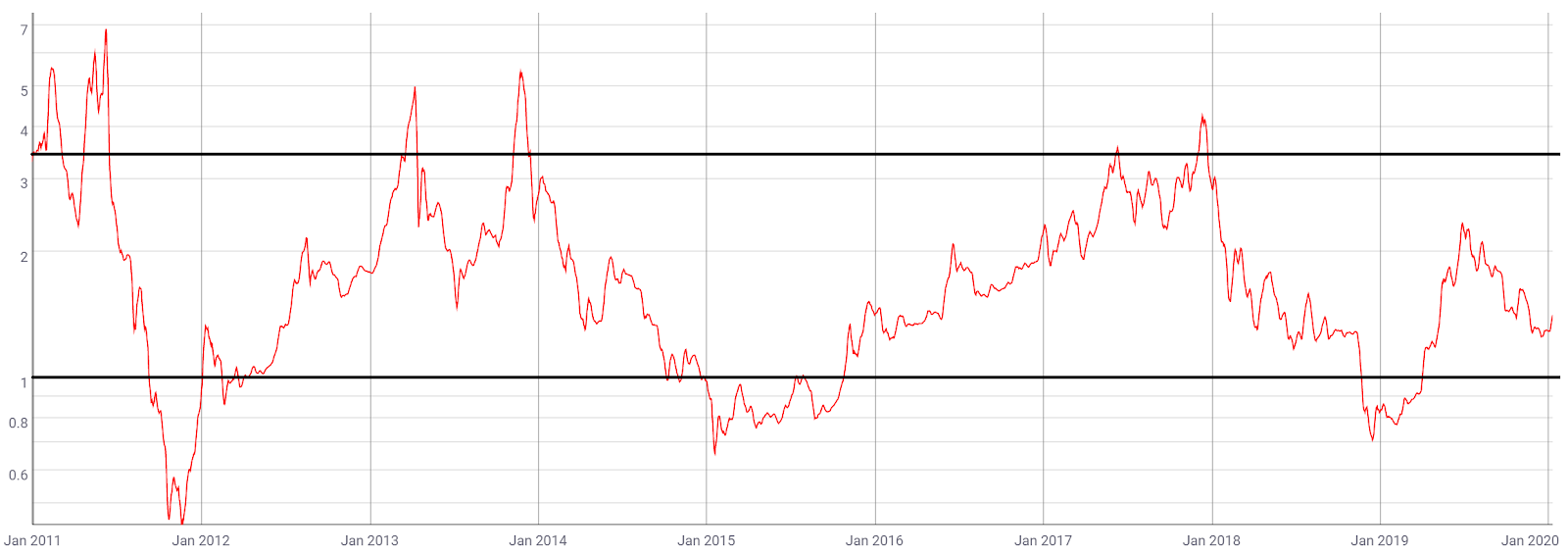
Analyzing the age of unspent transaction outputs (UTXOs), or unspent coins, can also provide some insights into price movements. Spikes in newly moved coins tend to correlate with local tops or bottoms in market values, and can represent euphoria or capitulation. Coins which have not moved recently are represented in cooler colors wheres as coins on the move are represented by warmer colors.
Coins that have not moved in more than five years (dark blue) account for 21.62% of the circulating supply, or 3.925 million BTC. The six to twelve month age band (yellow), or coins not moved since March 2019 - November 2018, holds the next highest distribution at 14.98%. The one to the three-month band (orange) had gained 5% since April 2019, but has fallen in recent months. Historically, local tops in price have occurred when the one to three-month band, currently 7.83%, has represented more than 15% of all circulating UTXOs.
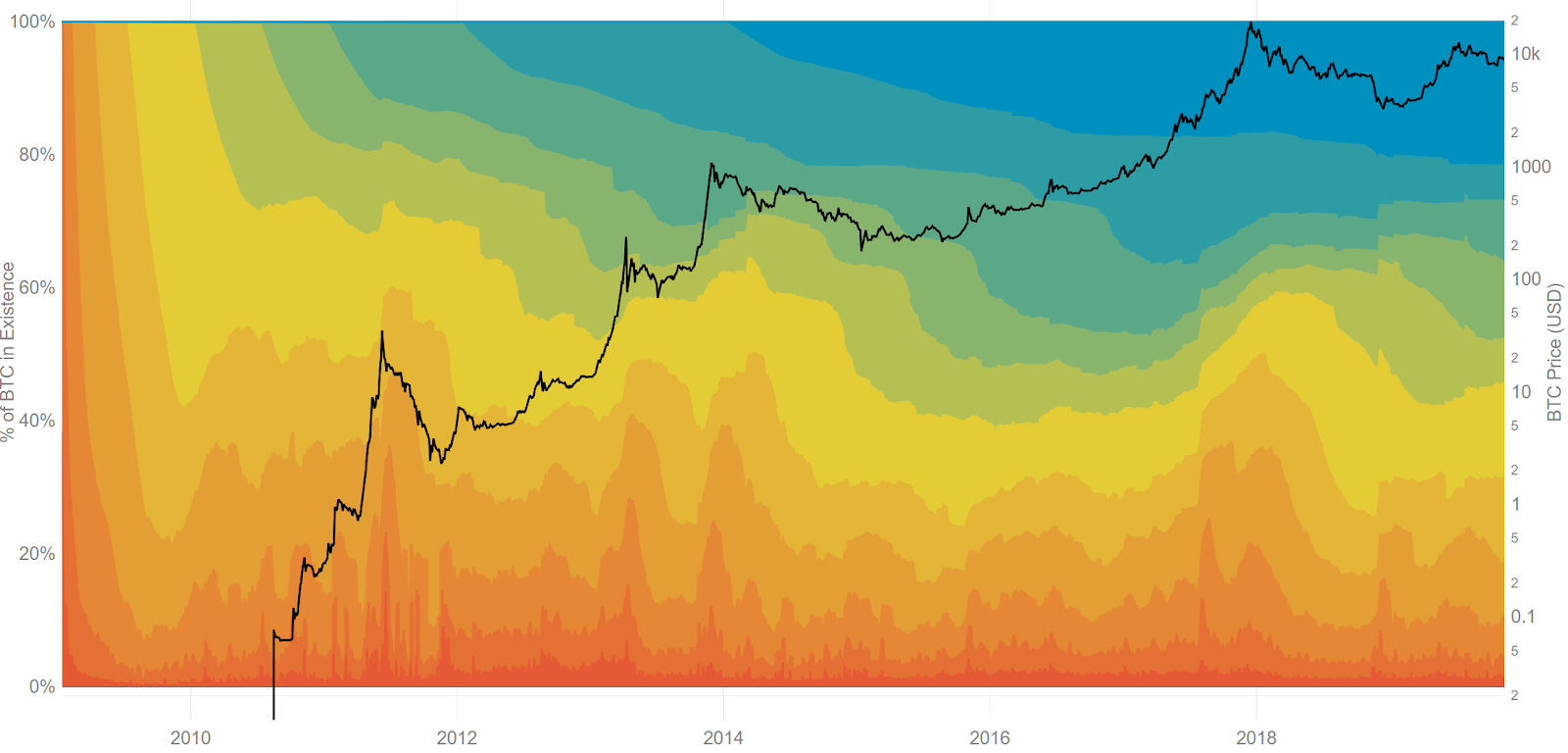
Turning to developer activity, Bitcoin Core version 0.18.1 was released in August 2019 and provided various bug fixes and performance improvements. Future potential protocol improvements in the pipeline include Schnorr signatures, Taproot, and Graftroot.
Schnorr signatures and signature aggregation also bring the potential for storage and bandwidth reduction by at least 25%. Taproot and Graftroot improve upon Merkelized Abstract Syntax Trees (MAST) which offers three benefits; smaller transactions, more privacy, and larger smart contracts.
In September 2019, Pieter Wuille of Blockstream also unveiled plans for miniscript, a simplified way to write Bitcoin code. The current version, Script, is complex and difficult to use for those not intensely familiar with the language.
According to Wuille, miniscript allows a user to write “[some] Bitcoin scripts in a structured, composable way that allows various kinds of static analysis, generic signing, and compilation of policies.” Miniscript is in the early stages of development and is currently being tested internally at Blockstream.
More than 170 developers have contributed nearly 2,000 commits in the past year, mostly on the main repo. Most coins use the developer community of GitHub where files are saved in folders called "repositories," or "repos," and changes to these files are recorded with "commits," which save a record of what changes were made, when, and by who. Although commits represent quantity and not necessarily quality, a higher number of commits can signify higher developer activity and interest.
The BTC project on Github has two active repos, “bitcoin” (top chart, shown below) and Bitcoin Improvement Protocols, “BIPs” (bottom chart, shown below).


BTC exchange-traded volume over the past 24 hours has been dominated by Tether (USDT) trading, with the United States Dollar (USD) markets representing 4.33% of the total volume. Tether is a stable coin with a soft peg to the USD. Stablecoins in general currently represent nearly 90% of all reported volume over the past 24 hours.
In 2019, VanEck-SolidX once again withdrew its BTC ETF proposal from the Securities and Exchange Commission (SEC) review process. All previous ETF proposals thus far have been rejected by the U.S regulator. So far, the SEC has delayed decisions on all active BTC ETF applications. However, there are already several BTC ETNs available, from various jurisdictions across the globe, which are seeing increasing volumes.
In place of a traditional ETF, VanEck-SolidX introduced a limited version of a BTC ETF, made available to qualified institutional buyers. The 144a product currently has US$511,000 under management. The Bakkt physically-settled BTC futures exchange launched in September 2019 and has seen increasing volumes throughout 2019. Bakkt and the Chicago Mercantile Exchange (CME) will both likely also have a BTC options product released by Q1 2020, with the CME product set to launch this week.
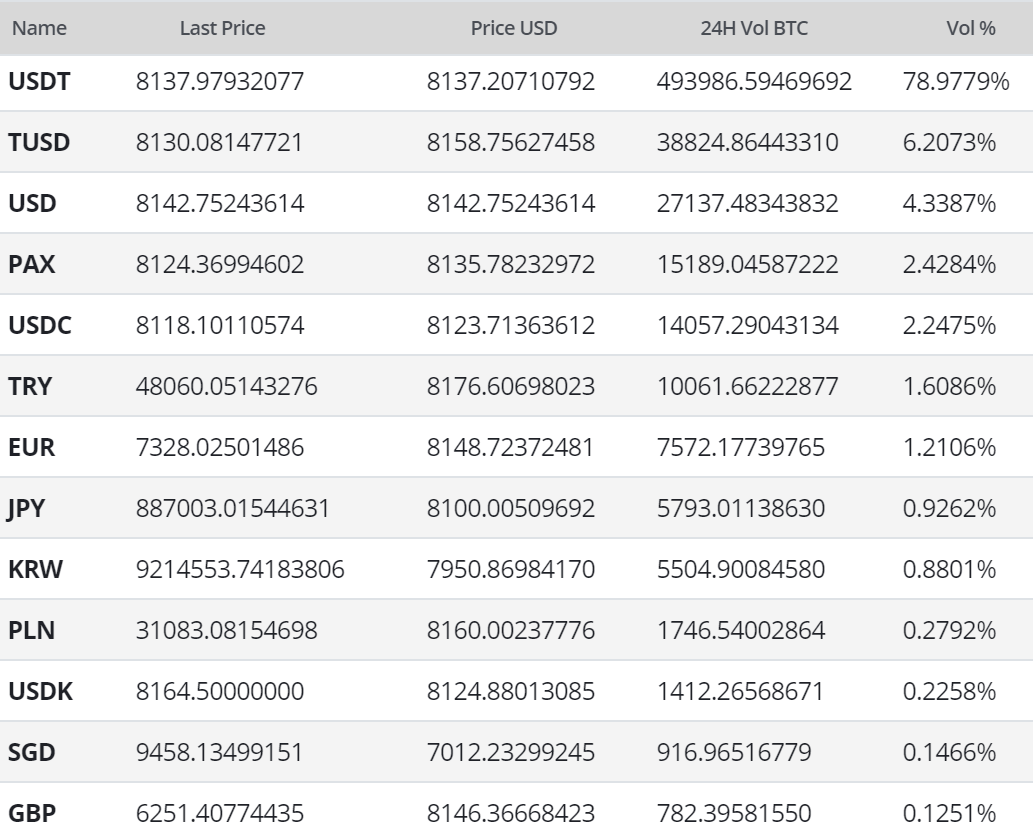
Global over the counter (OTC) volume, from LocalBitcoins.com, finished 2017 on a high and has declined since July 2019 as BTC spot prices have decreased. Global notional volume has held near or above US$50 million since the beginning of the year. In late May, LocalBitcoins discontinued servicing Iran, likely as a result of U.S sanctions and on June 1st, the option to pay for BTC in person with cash was disabled.
Latin America (brown) holds the highest percentage of total notional volume, followed by Eastern Europe (orange). The Middle East (yellow) and the Australia/New Zealand regions (grey) hold the lowest notional volume, both posted less than US$500,000 in trade volume over the past week. Notional volumes for Venezuela and Columbia stand at US$4.77 million and US$1.76 million, respectively. Venezuela’s central bank also announced plans to hold BTC within its reserve system.

Worldwide Google Trends data for the term "bitcoin" increased dramatically from March to June last year, marking a new yearly high. Since June, search interest has continued to drop, is now nearing a multi-year low.
The previous increase in search traffic has likely been related to both the sharp increase in price in Q2 as well as mentions from several prominent U.S government officials, including the President of the United States. Throughout the course of 2018, “bitcoin” related searches declined dramatically. Despite the declining interest, the search “what is bitcoin” was the most popular “what is” Google search of 2018.
A slow rise in searches for "bitcoin" preceded the bull run in Q4 2017, likely signaling a large swath of new market participants at that time. However, a 2015 study found a strong correlation between google trends data and BTC price whereas a 2017 study concluded that when U.S. Google "bitcoin" searches increased dramatically, BTC price dropped.

Technical Analysis
On the daily chart for the BTC/USD market, the spot price relative to the 50-day Exponential Moving Average (EMA) and 200-day EMA can be used as a litmus test for the trend. From mid-September 2019 until October 26th, the spot price remained below the 50-day EMA. These key EMAs are currently in a bearish cross but a bullish cross in the coming weeks should bring continued bullish momentum. The 50-day EMA is currently at US$7,617, while the 200-day EMA is currently at US$8,154 and acting as resistance.
The volume Profile of the Visible Range (VPVR) shows large volume nodes at US$6,500 and US$8,200, which should act as support and resistance, respectively (horizontal bars, chart below). VPVR shows relatively little resistance above the current price level until US$10,000. Additionally, yearly Pivot Points, at US$13,000 and US$18,600, should both act as resistance. If the spot price breaches the nearest resistance Pivot Point, the next historic resistance zone is US$22,000.
The Bitfinex long/short ratio (top panel, chart below) is currently 90% long, with longs increasing significantly over the past week and shorts continuing to decrease since September 2019. A significant price movement downwards will result in an exaggerated move further, as the long positions will begin to unwind. This is known as a “long squeeze.” There are no RSI or volume divergences at this time.
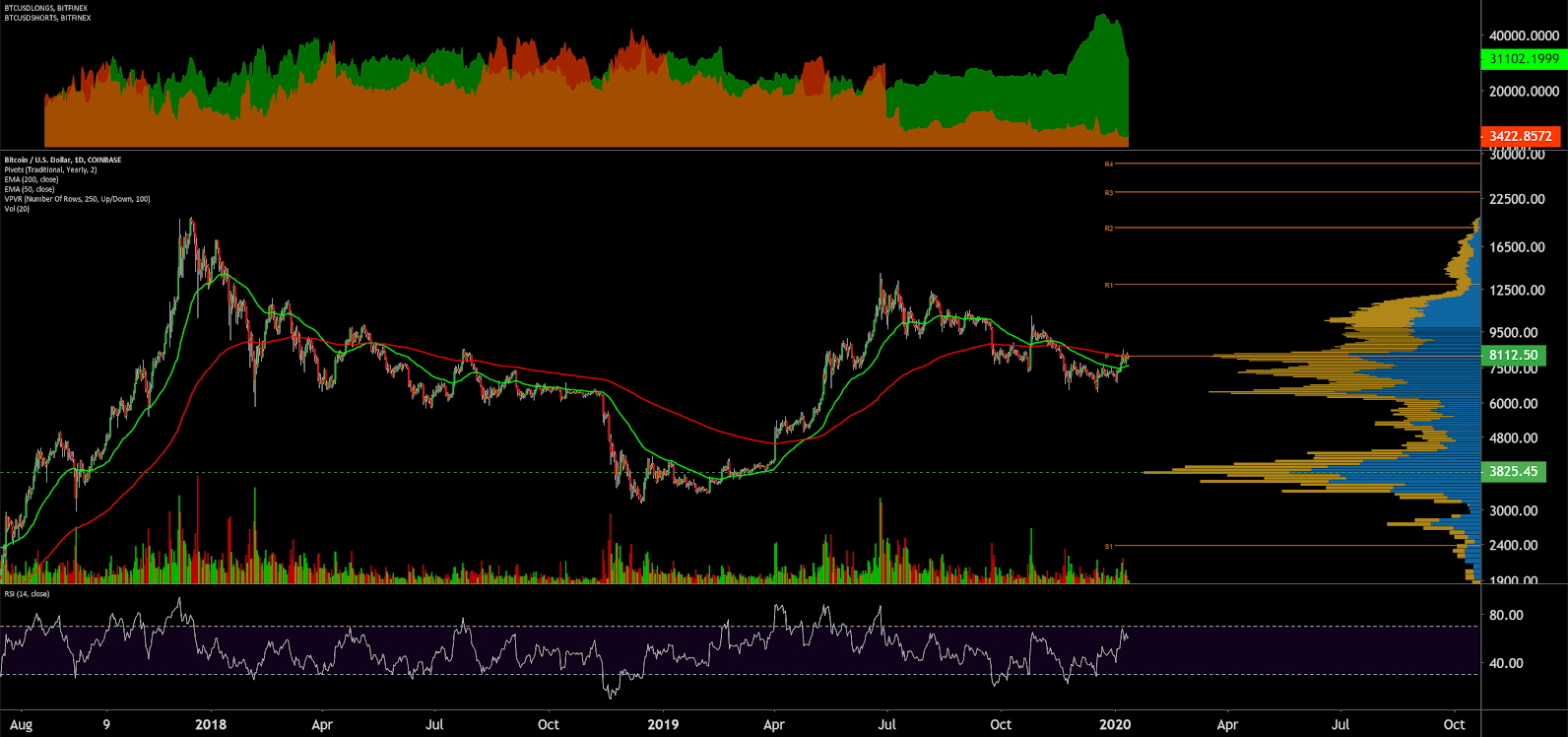
A high timeframe Pitch Fork (PF) with anchor points in January, July, and August 2015 shows price reaching the upper resistance limit of US$14,000 in late June and then returning to the median line (yellow). Throughout any given trend price returns to the median line several times.
The previous price break above the PF resistance led to a run toward the current record high at nearly US$20,000. The lower bound of the PF stands at US$7,000 and represents the last support before significant bearish momentum. This PF also projects a near-term price target of US$14,000 and a long-term price target of US$20,000 by July 2020.

Turning to the Ichimoku Cloud, there are four key metrics; the current price in relation to the Cloud, the color of the Cloud (red for bearish, green for bullish), the Tenkan (T) and Kijun (K) cross, and the Lagging Span. The best entry always occurs when most of the signals flip from bearish to bullish, or vice versa.
On the daily chart, Cloud metrics are bearish to neutral; the spot price is inside the Cloud, the Cloud is bearish, the TK cross is bullish, and the Lagging Span is below the Cloud and above the spot price. The trend will remain bearish so long as the spot price remains below the Cloud.

Lastly, the opening and expiration dates of the Chicago Mercantile Exchange (CME) BTC cash-settled futures contracts, launched in December 2017, have had a significant impact on price. The CME facilitates trades for the largest portion of derivatives contracts in the world.
In July, the CME saw the highest notional volume ever in a single day for the BTC futures product, exceeding US$1.5 billion. Historically, price volatility tends to increase dramatically near any active contract expiration, as was again the case leading into September 27th. The July 1st to December 27th contract yielded an excellent short trade for the entirety of the contract, which is similar to the bi-annual contract of the same time period in 2018.
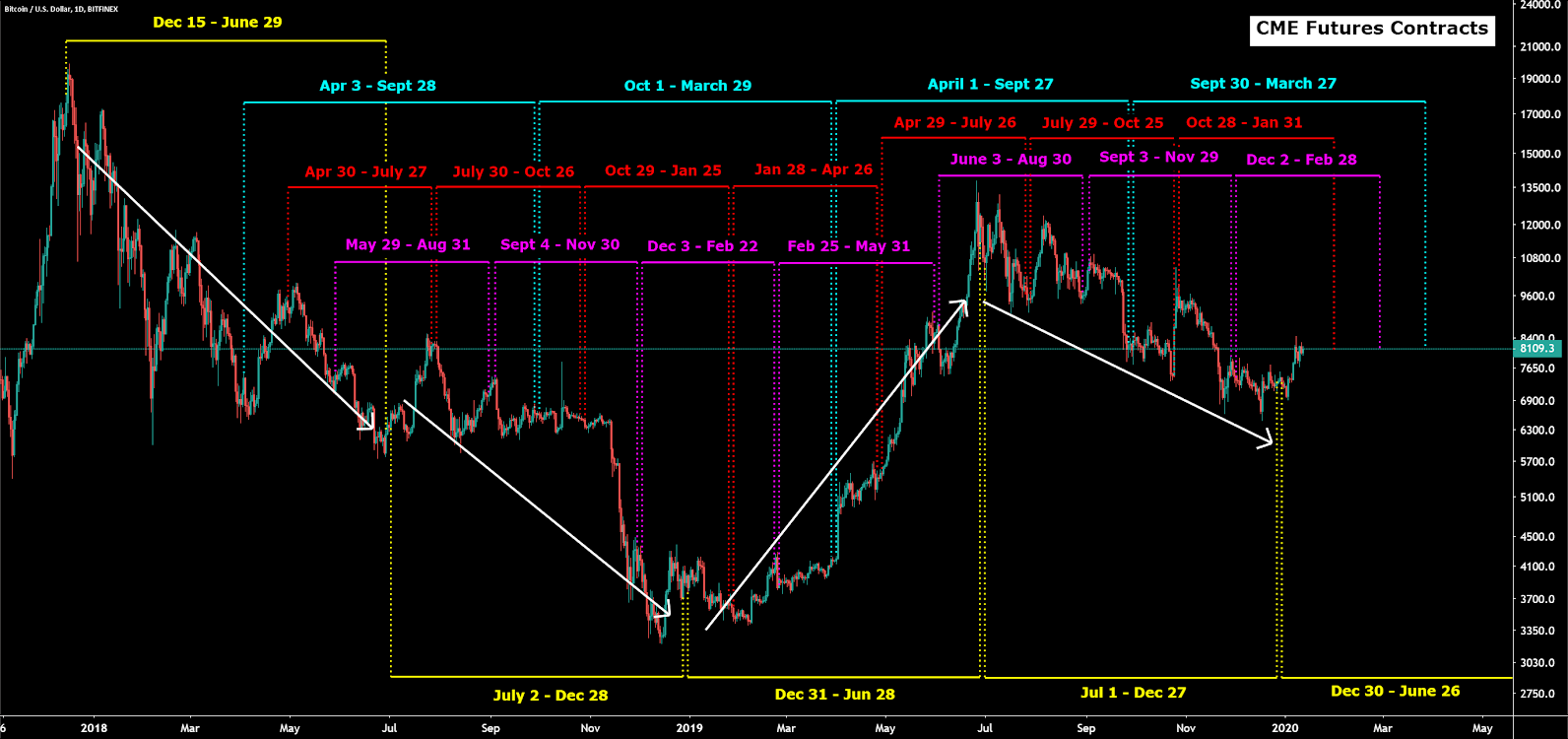
Conclusion
Network mining fundamentals have once again begun to heat up in the new year with a new hash rate and difficulty all-time high. If the hash rate continues to increase over the next few months, the block reward halving will occur much sooner than the currently projected May date.
Although transactions per day have increased over the past few weeks, monthly active addresses have declined in the same time period. Both NVT and MVRV, which are inversely related to on-chain activity, have also begun increasing over the past few weeks, suggesting weakening on-chain use relative to the Bitcoin market cap.
Technicals suggest a potential trend shift as the BTC/USD spot price returns to the 200-day EMA and enters the daily Cloud. A fully-fledged bull market is unlikely to form until the spot price is above the 200-day EMA and the daily Cloud, with a bullish 50-day and 200-day EMA cross.
OhNoCrypto
via https://www.ohnocrypto.com
Josh Olszewicz, Khareem Sudlow
